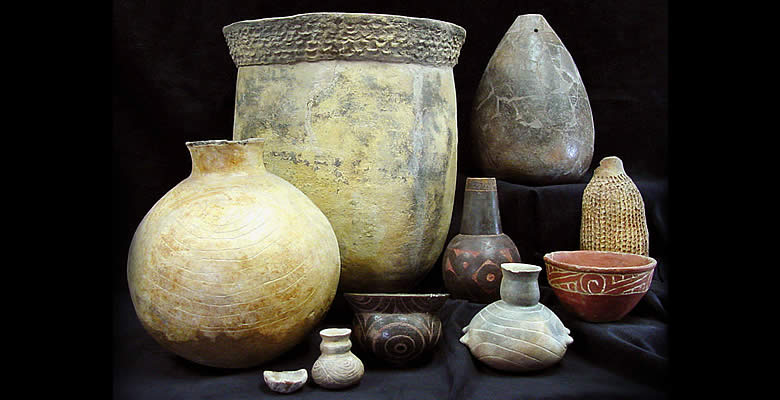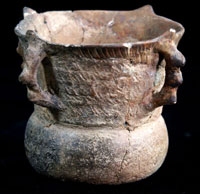
Odd little pot with four, spiked
handles. Nash Neck Banded jar, Late Caddo, ca. A.D.
1400-1650. TARL collections.
|
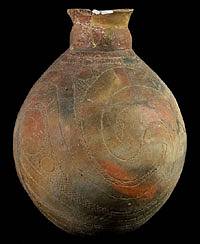
This olla has a short neck with a
flaring rim and a small mouth. These features suggest
that it served as a water jar or dry storage jar that
could be sealed by tying a skin cover over the mouth.
Hodges Engraved olla, Late Caddo, ca. A.D. 1400-1600.
TARL collections
|
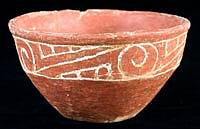
Example of the use of white pigment
(probably kaolin) to fill the engraved lines, thus heightening
the contrast with bright red bowl. Ripley Engraved bowl,
Late Caddo, ca. 1400-1650. TARL collections.
|
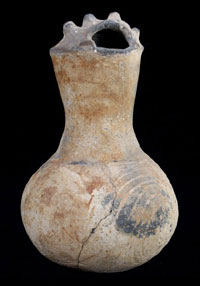
Small engraved bottle with highly
unusual "spiked gaping mouth." Taylor Engraved
bottle, Late Caddo, ca A.D. 1400-1650. TARL collections.
|
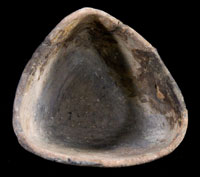
Looking down into small triangular
engraved bowl. Untyped, Late Caddo, ca. A.D. 1400-1650.
TARL collections. Click on image for enlarged view and
alternative view.
|
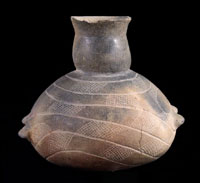
Hodges Engraved bottle with unusual
oblong form and pairs of nodes at both ends. Late Caddo,
ca. A.D. 1400-1650. TARL collections.
|
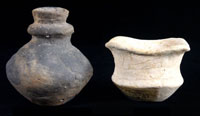
Miniature pottery probably made for
children. Untyped, Historic Caddo, after A.D. 1650.
TARL collections.
|
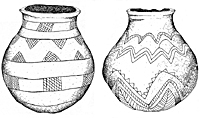
These decorated jars are believed to have been made at
the Brazos Reserve in the 1850s. These two and another
similar pot are in the Brooklyn Museum and were collected
by medical doctor. The vessel form and decorative designs
are immediately recognizable as Caddo in origin and probably
derived from one of the Kadohadacho groups. They show
that the fine ware tradition survived into the mid-1850s.
Drawn by Nancy Reese. From Perttula, 2001. |
|
Why Study Caddo Pottery?
Why do the archeologists who study the ancient
Caddo spend such an inordinate amount of time and effort excavating,
reconstructing, and studying Caddo pottery? For archeologists,
Caddo pottery is the prime evidence used to identify and date
ancient traces of the Caddos' past. Lacking potsherds, we
could scarcely identify the vast majority of Caddo archeological
sites as being Caddo. While there are many other distinctive
kinds of archeological evidence of Caddo life, such as house
patterns, pottery remains indispensable for understanding
the past for three main reasons.
First, the ancient and early historic Caddo
were superb potters and made and used lots of pottery. Sites
representing small farmsteads where a single family once lived
for short durations will have hundreds of potsherds. Villages
and ceremonial centers often have tens or hundreds of thousands
of potsherds and, in graves, many whole or almost whole pots.
Secondly, pottery is relatively durable and can often be identified
by style and form even when broken into small fragments. Thirdly,
Caddo pottery is tremendously varied—different forms
or shapes, different decorative designs, different colors,
different finishes, different sizes, and so on. Further, pottery
styles and preferences changed through time and varied from
place to place within the Caddo Homeland. Given the right
sherd, an expert often can tell approximately where the pottery
was made and how old it is, give or take a few centuries (or
sometimes a few decades). This is because we know what whole
Caddo pottery vessels look like.
The Caddo pottery tradition was tied to the
Caddo funerary tradition of placing whole pottery vessels
in the graves of departed loved ones. The vessels may have
contained food and drink to accompany the deceased in the
afterlife or they may have been prized personal possessions
(or both). Some burial pottery is obviously worn from use,
but other vessels show no wear and look like they were interred
in a fresh, newly made condition, perhaps representing gifts
from loved ones. Whatever the case, the ancient Caddo must
have considered pottery important because they included pottery
vessels as grave offerings more frequently than any other
non-perishable material. Clothing, mats, baskets, and objects
made of wood may have been more common, but these things usually
decay quickly. (The typically acidic soil in the Caddo Homeland
destroys virtually all organic materials, including human
bones, over time.)
Whole pots are also found in other contexts
besides graves, especially on the floors of houses. For instance,
over 30 vessels of various sizes and forms were recently found
on the floor of a house at the Tom Jones site in the Little
River Valley in Arkansas. Most of these were broken by the
collapse and burning of the house. (Many pots included as
grave offerings are also broken.) For the archeologist, a
reconstructed pot is every bit as informative as a never-broken
vessel.
The ancient Caddo tradition of including offerings
of pottery in graves has led to the excavation of thousands
of Caddo graves, some by archeologists and many more by looters
("pothunters") seeking pottery for personal collections
and, increasingly, to sell for profit. No one really knows
how many, but tens of thousands of vessels have been removed
from Caddo graves. Many are traded or sold on the antiquities
market in the United States, Europe, and Asia. Some spectacular
Caddo vessels are rumored to have sold for over $20,000. Even
ordinary Caddo pots can bring hundreds of dollars on the market.
The desecration of Caddo cemeteries has long
been a source of anguish to Caddo people (and Caddo archeologists).
As explained in the "Graves
of Caddo Ancestors" section , the Native American
Graves Protection and Repatriation Act (NAGPRA) of 1990 has
put the fate of most of the Caddo pottery vessels excavated
from graves by archeologists in the hands of the Caddo Nation
of Oklahoma. (NAGPRA applies to federal agencies, federally
funded or permitted excavations, on federal and tribal land,
as well as to all museums and institutions that have received
federal funding. While this effectively covers most grave
goods excavated by professional archeologists, the law does
not pertain to graves dug up on private land or grave goods
in private hands.)
Caddo people are conflicted—they want to
honor their ancestors, but they are not sure that reburying
all grave goods and bones in mass or separate graves hundreds
of miles from their original resting places, as some tribes
have chosen to do, is the right thing to do. Another possibility
being considered by the Caddo is to expand their own tribal
museum so that pottery vessels and other grave goods can be
treated properly and preserved for future generations as sources
of pride and knowledge about the past.
Regardless of what happens in the future, Caddo
pottery was important to the ancient Caddo, it is important
to the Caddo Nation today, and it is important to anyone who
wants to understand ancient Caddo history.
Origin and Development of the Caddo Pottery Tradition
When we say that the Caddo pottery tradition
began about A.D. 800, we do not mean to imply that earlier
ancestors of the people known today as the Caddo were not already
making pottery. Clearly they were. But we do not know exactly
how, when, or even where, the Caddo pottery tradition was
first established. Partly this is because it is often impossible
to recognize the origin or beginning of any complex phenomenon
in the ancient past. And partly it is because we have so few
well-excavated and well-dated Late Woodland and early Caddo
sites.
In part, the Caddo pottery tradition grew out
of the Fourche Maline pottery tradition that developed during
the Middle and Late Woodland periods. Like early Caddo pottery,
Fourche Maline pottery was usually grog or bone tempered and
it was sometimes burnished. But Fourche Maline pottery was
rarely decorated and it is very thick-walled in comparison
to the Caddo fine wares. Vessel forms are also very different
between the two traditions. Some of the favorite Caddo decorative
techniques, incising and punctating, are found on Fourche
Maline pots, but most of the designs are very simple.
The inspiration for these decorative techniques
almost certainly lies to the southeast in the Woodland cultures
of the lower Mississippi Valley (LMV). Beginning with Tchefuncte
pottery (800-200 B.C.) and continuing on into the Middle Woodland
period (200 B.C. to A.D. 500) with Marksville pottery, incised,
stamped, and puncated designs were common. Trade pieces of
Tchefuncte and Marksville pottery are found in the Caddo area.
By Late Woodland times (ca. A.D. 500-800/900) Fouche Maline
potters began to copy the designs of Coles Creek pottery from
the LMV.
The origin of the technique of filling the engraved
patterns with pigments and the origin of the distinctive early
Caddo vessel forms—long-necked bottles and carinated
bowls—is not known. We do not see clear precedents in
the Woodland-period pottery of either the Caddo Homeland or
the Lower Mississippi valley, or the central Mississippi valley,
or the Arkansas Basin. Therefore, we suspect that one of two
things happened: ancestral Caddo potters invented these techniques
for themselves or they borrowed the ideas from distant cultures.
Archeologists have struggled with explaining
the origin of highly specific behaviors for decades—are
these "independent inventions" or the result of
the "diffusion" (spread) of ideas or of things like
domesticated plants? In the 1940s, Alex Krieger and Clarence
Webb, like many of their contemporaries, favored the diffusion
explanation. These Caddo scholars and other prominent American
archeologists of the day pointed to seemingly close parallels
between Caddo pottery and the pottery of certain Mesoamerican
cultures in what is today Mexico and Guatemala. They could
not explain how the contact between these very different and
widely separated (in space and time) cultures took place.
Nor could they point to positive evidence of direct contact,
such as the finding of a pot made in Mesoamerica at a Caddo
site (or vice versa).
Caddo archeologists today reject the notion
of a Mesoamerican origin and see the Caddo pottery tradition
as an independent development influenced only by neighboring
peoples living mainly to the east along the Mississippi River
and along the Gulf coast. The diverse Caddo pottery tradition
bears witness to the obvious inventiveness of Caddo potters
and their willingness to experiment. It is worth pointing
out that there are a great many cases across the world of
the obviously independent invention of specific forms of pottery
making and decoration. Carinated pottery, long-necked earthenware
bottles, and engraved designs with pigment all occur in many
places in the world that are separated by thousands of miles
or thousands of years (or both). For instance, carinated pottery
forms similar to those of the Caddo tradition are also found
in Mesoamerica, South America, Africa, Europe, and Asia.
Thus it seems likely that about 1200 years ago,
ancestral Caddo potters began to develop their own distinctive
pottery tradition by combining the established ways of making
pottery (the Fourche Maline tradition and probably that of
the Mill Creek and Mossy Grove traditions) with inspirations
from neighboring peoples, and creative new ideas cooked up,
so to speak, in Caddo villages by Caddo potters. By A.D. 1000,
the Caddo pottery tradition was firmly established and distinct
from all others.
While some variation is apparent across the
region, Early Caddo pottery seems to vary much less from place
to place than would be the case a few hundred years later.
Compared to the Caddo potters in later times (after A.D. 1400),
early Caddo potters used fewer decorative techniques, applied
decoration to larger areas of the surface of their fine wares,
and left most of their utilitarian wares undecorated. They
also favored bowl forms, especially carinated bowls, and bottles,
although they made jars, plates, effigy vessels, and compound
bowls, among other forms. Decorative designs were typically
curvilinear, rectilinear, and horizontal. The relative homogeneity
of early Caddo pottery is thought to be the result of broad
and extensive social interaction among Caddo groups
After A.D. 1400, Caddo pottery became more diverse
in form and, especially, in decorative technique and style.
Caddo potters developed (or borrowed) new decorative techniques
including appliqué, trailing (wide incisions, often
curved), brushing, and a great many combinations. Intricate
scroll designs with ticked lines, incised circles, negative
ovals and circles, triangles, and ladder designs are all common
in late Caddo pottery. Jar forms seem to have become more
important and bottles somewhat less so. New specialized vessel
forms such as rattle bowls and "tail-rider" effigy
bowls appear, the latter closely resembling vessel forms in
northeastern Arkansas. Very rare examples of Caddo pots made
in the style of Mississippian head pots are also known.
More than anything, the Late Caddo period was
the time during which many local styles were created. In part
this probably represents higher population levels (more people
making pottery), but it also seems to reflect the existence
of more social groups, each with its own local pottery tradition
handed down and elaborated on from generation to generation.
It is likely that the local styles were quite intentionally
made different from one another as an expression of the identities
of each Caddo community. Alice Cussens, daughter of Mary Inkinish,
told a WPA interviewer in 1937 or 1938: "each clan had
its own shape to make its pottery. You could tell who made
the pottery by the shape." [From David La Vere, 1998,
Life Among the Texas Indians, where her name is given
as Mrs. Frank Cussins. She was born in about 1885, by which
time neither Caddo pottery making nor Caddo clans survived
intact. Hence her words must reflect what she learned from
her mother.]
The invasion of European peoples and the attendant
catastrophic impacts on the Caddo (population loss, forced
moves, changing economy, etc.) brought about a relatively
quick end to the Caddo pottery tradition. For a time in the
late 17th and early 18th centuries Caddo women were able to
keep making beautiful and distinctively Caddo pottery, but
by the close of the 19th century, only vestiges of the tradition
survived. The last Caddo pottery of the original tradition
was apparently made in the late 1800s after the move to Oklahoma.
Today, as can be seen in other sections of this
exhibit, there is hope that the Caddo pottery tradition will
be revived, at least as an art form. Of course the tradition
will never be the same without the existence of the societies
that kept it going. Modern Caddo people use store-bought pots
and pans, just like everybody else in the developed world.
|
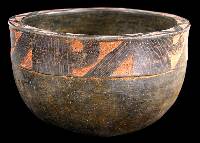
Finely crafted Holly Fine Engraved
bowl, Early Caddo, ca. A.D. 900-1200. TARL collections.
Click to see top view.
|
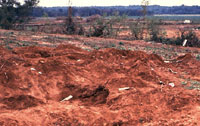
Looted Caddo cemetery in northeast
Texas. Photo courtesy Texas Historical Commission.
|
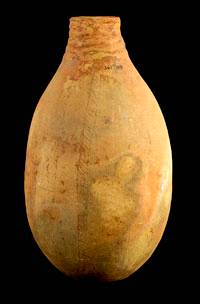
Late Caddo bottle with poorly smoothed
neck bands and faint ladder-like design on main body.
Hume Engraved bottle, ca. 1400-1650. TARL collections.
Click on image for enlarged view and detail of neck.
|
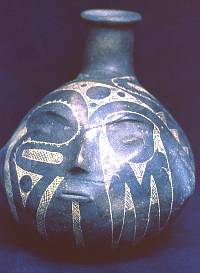
A rare Late Caddo "head pot"
from southwestern Arkansas. The Caddo master potter
who made this extraordinary piece obviously copied a
typical Mississippian head pot, but decorated it with
Caddo style engraving rather than painting. The engraved
designs may mimic facial tattooing. Courtesy Picture
of Records, original in the Henderson State University
Collection, Arkadelphia, Arkansas.
|

These peculiar little vessels are
rattle bowls. The protruding nodes are hollow and contain
small pebbles or rounded pieces of clay that rattle
when the bowl is shaken.
Late Caddo, ca. A.D. 1400-1650. TARL collections. Click
to see enlarged view and close up of one bowl. |
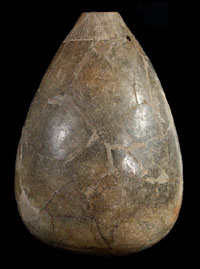
Large tear-drop or gourd-shaped Sanders
Engraved "seed pot," so-called because of
the small restricted mouths. In fact, there is no definitive
evidence that such vessels were used to store seeds.
This one is much too thin to have been a water jar and
it does have small holes near the rim that were probably
used to secure a lid, lending support to the seed pot
notion. Middle Caddo, ca. A.D. 1200-1400. TARL collections.
Click to see enlarged view and detail of rim.
|
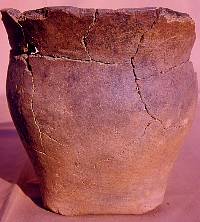
Typical Fourche Maline jar with thick
walls and a shape resembling a flower pot. This Williams
Plain pot is from the Crenshaw site, Miller County,
Arkansas. Photo by Frank Schambach.
|
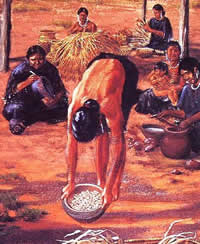
Detail of artist's depiction of daily life in an Early
Caddo village. The woman on the far left is engraving
a bowl. Courtesy artist George Nelson and the Institue
of Texan Cultures. |
|
